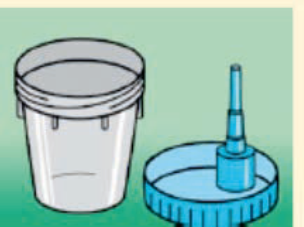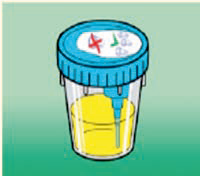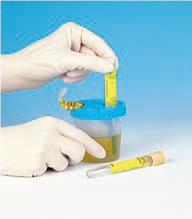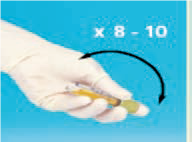Urine sampling with a closed vacuum system
The purpose of this leaflet is to teach the patient how to correctly collect a urine sample using a closed vacuum system, so that the urine test gives an accurate and reliable result.
Preparation for urine sampling
First morning urine is most suitable for urinary strip analysis, urinary precipitation microscopy, clinical chemistry, and microbiological studies.
-
To collect a urine sample, you have been given marked (barcode with your name and personal identification code) sample containers: a sample cup and vacuum tube(s).
-
Write the date and time of urine collection on the vacuum tube.
-
At least 4 hours should have passed since your last urination.
-
You must not eat or drink for 8 hours before taking the urine sample.
Urine sampling
-
Wash your hands and the urethral area with warm water before collecting the urine sample. Do not use soap or disinfectants. Dry with a paper towel.
-
Remove the lid from the sample cup (Figure 1) and place it at your fingertips without touching the inner surface (sticker down, suction nozzle up).

Figure 1. Sample cup and lid
3. Start urinating into the toilet and, after a few seconds, without interrupting the flow of urine, urinate in the sample cup, filling approximately 3⁄4 of the sample cup (at least 50 ml). Finish urinating in the toilet.
4. Securely tighten the lid of the sample cup, shake the urine in the sample cup and partially open the protective sticker (Figure 2).

Figure 2. Protective sticker of the sample cup
Filling of vacuum tube(s)
Do not remove the cap of the vacuum tube!
After a urine sample has been taken, the tube(s) should be filled according to the tests prescribed for you.
Order of filling of vacuum tubes:
-
Beige cap tube (conventional and clinical chemistry studies)

2. Olive green protective cap tube (microbiological examination)

Figure 3. Vacuum tube caps
Fill the vacuum tube(s) within 15 minutes of collecting the sample, to ensure that the urine sample is preserved correctly.
Push the vacuum tube through the opening in the lid of the sample cup, the cap facing the bottom of the sample cup (Figure 4). The vacuum tube fills with urine. Hold the tube in place until the urine flow stops.
Fill in the second vacuum tube, if necessary. Then close the opening of the sample cup again with the sticker.
Slowly turn the bottom of the vacuum tube(s) 8-10 times up and down (Figure 5) to dissolve the preservative in the tube.

Figure 5. Inverting the vacuum tube
Pour the remaining urine from the sample cup into the toilet and throw the sample cup into household waste.
Keep the urine sample at 15–25°C or 2–8°C. Deliver the vacuum tube(s) to the laboratory within five (5) hours of sampling.
Only deliver filled and marked vacuum tube(s) to the laboratory.
The information material has been compiled by the Central Laboratory of Aktsiaselts Ida-Tallinna Keskhaigla and Surgitech.
ITK1077
Approved by the decision of the Medical and Nursing Care Quality Commission of Aktsiaselts Ida-Tallinna Keskhaigla on 17.12.2025 (Protocol No. 2.2-8/10-25)
 Terviseportaal
Terviseportaal